White-Label API Guide
Build Your Own UI with Meld APIs
This comprehensive guide walks you through building a custom cryptocurrency interface using Meld's White-Label API Integration. Perfect for developers who want complete control over the user experience while leveraging Meld's crypto infrastructure.
Important: This is White-Label API Integration, NOT Widget Integration (Public Key URL). This approach requires custom UI development and API integration.
CRITICAL: API Changes & CompatibilityNon-Breaking Changes (No Versioning):
- New fields may be added to API responses at any time
- Your system MUST handle unexpected fields gracefully
- Avoid strict JSON validation that rejects unknown properties
Breaking Changes (Versioned):
- Field modifications or deletions will be versioned
- Released approximately with advance notice
Required Actions:
- ✅ Use flexible JSON parsing (ignore unknown fields)
- ✅ Implement defensive coding practices
- ✅ Test with mock responses containing extra fields
IMPORTANT: Automatic Onramp Provider ManagementAutomatic Additions:
- Meld may automatically enable onramps for your account based on:
- Conversion rates and user success
- Competitive pricing
- Geographic coverage for your users
Automatic Removals:
- Onramps may be disabled due to:
- Compliance or regulatory issues
- Technical problems or outages
- Provider service interruptions
Manual Control:
- Contact Meld to opt out of automatic management
- Request specific provider additions/removals
- Set custom provider preferences for your account
Prerequisites
Before starting, ensure you have:
- ✅ API key from the Meld dashboard
- ✅ Webhook endpoint (recommended)
- ✅ Basic understanding of REST APIs
- ✅ Development environment set up
New to Meld? Complete the Quick Start Guide first to get familiar with the basics.
Step 1: Get User Location
Get the user's country to set default values and compliance requirements.
Best Practice: Ideally, automatically detect the user's country from their device/browser using geolocation or IP detection rather than prompting them to manually select.
Auto-Detection (Recommended):
// Sample Code: Auto-detect user's country
function detectUserCountry() {
// Option 1: Browser geolocation API
if (navigator.geolocation) {
navigator.geolocation.getCurrentPosition((position) => {
const country = getCountryFromCoordinates(position.coords);
return country;
});
}
// Option 2: IP-based detection
const country = await fetch('/api/detect-country').then(r => r.json());
return country;
}Manual Override Option:
If users choose to override the auto-detected country, they can get a list of supported countries and flags from this API:
// Sample Code: Get supported countries list with flags
GET /service-providers/properties/countries?accountFilter=trueFor US Users - State Requirements:
// Sample Code: Also collect state information for US users
// Some US states have heavy restrictions on crypto and may not be supported
const location = "US-NY"; // Format: Country-State Screenshot: Meld Widget showing automatic country detection with manual override option
Screenshot: Meld Widget showing automatic country detection with manual override option
API Response Example:
{
"countries": [
{
"countryCode": "US",
"countryName": "United States",
"states": ["US-NY", "US-CA", "US-TX", ...]
},
{
"countryCode": "GB",
"countryName": "United Kingdom"
}
]
}Step 2: Get Currency and Payment Defaults
Based on the user's country, get default settings to streamline the experience.
Get Country Defaults:
// Sample Code: Get default currency and payment method for country
GET /service-providers/properties/defaults/by-country?countries={countryCode}Response:
[
{
"countryCode": "BR",
"defaultCurrencyCode": "BRL",
"defaultPaymentMethods": [
"PIX",
"CREDIT_DEBIT_CARD",
"BINANCE_CASH_BALANCE"
]
}
]
Note: Response is an array. Default payment methods returns an ordered list with the most recommended option first.
Get Available Fiat Currencies:
Users can choose to use a different fiat currency than the default, so call this endpoint to populate a currency selection menu:
// Sample Code: Get all available fiat currencies for the country
GET /service-providers/properties/fiat-currencies?countries={countryCode}&accountFilter=trueGet Payment Methods:
// Sample Code: Get payment methods available for selected fiat currency
GET /service-providers/properties/payment-methods?fiatCurrencies={fiatCurrency}&accountFilter=trueUI Implementation:
// Sample Code: Set defaults but allow user override
const defaults = countryDefaults[0]; // Get first country from response array
const userSettings = {
country: detectedCountry,
fiatCurrency: defaults.defaultCurrencyCode || 'USD',
paymentMethod: defaults.defaultPaymentMethods[0] // Use first (most recommended) option
};
// Provide dropdowns for user to change defaults
renderCurrencySelector(availableFiatCurrencies);
renderPaymentMethodSelector(availablePaymentMethods);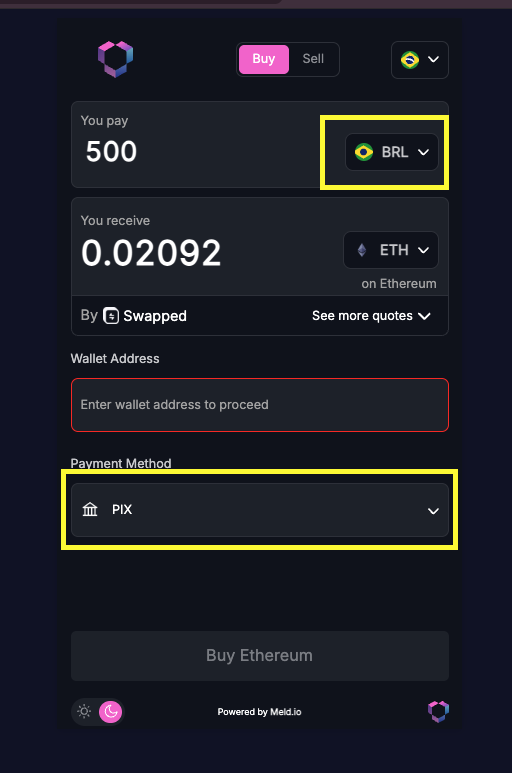 Screenshot: Meld Widget showing default fiat currency and payment method selection
Screenshot: Meld Widget showing default fiat currency and payment method selection
Step 3: Get Cryptocurrencies
Display available cryptocurrencies based on user's location and preferences.
API Call:
// Sample Code: Get available cryptocurrencies for the country
GET /service-providers/properties/crypto-currencies?countries={countryCode}&accountFilter=trueResponse Example:
{
"cryptoCurrencies": [
{
"currencyCode": "BTC",
"currencyName": "Bitcoin",
"networkCode": "BTC",
"networkName": "Bitcoin"
},
{
"currencyCode": "ETH_ETHEREUM",
"currencyName": "Ethereum",
"networkCode": "ETHEREUM",
"networkName": "Ethereum"
}
]
}UI Implementation:
// Sample Code: Create searchable crypto selector
function renderCryptoSelector(cryptoCurrencies) {
return cryptoCurrencies.map(crypto => ({
value: crypto.currencyCode,
label: `${crypto.currencyName} (${crypto.networkName})`,
icon: getCryptoIcon(crypto.currencyCode)
}));
}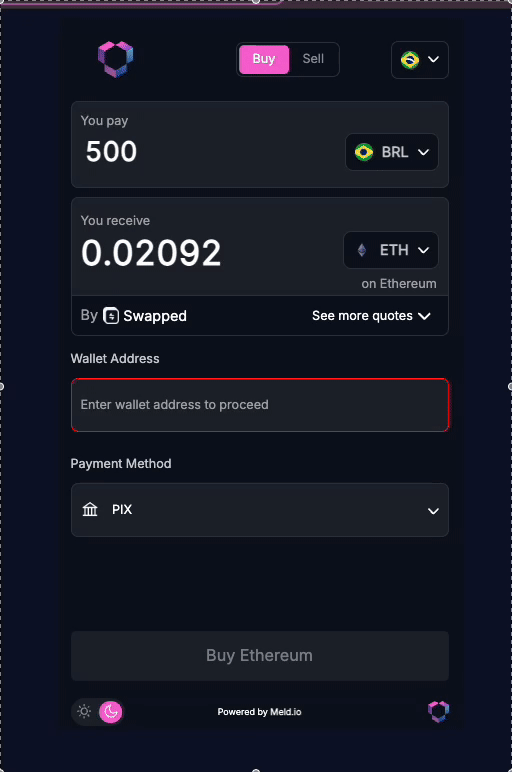 Screenshot: Meld Widget showing cryptocurrency selection interface
Screenshot: Meld Widget showing cryptocurrency selection interface
Step 4: Get Amount and Purchase Limits
Validate user input against provider limits and display helpful guidance.
Get Purchase Limits:
// Sample Code: Get purchase limits for validation
GET /service-providers/limits/fiat-currency-purchases?accountFilter=trueResponse Example:
{
"limits": {
"USD": {
"minAmount": 20,
"maxAmount": 20000,
"dailyLimit": 5000,
"monthlyLimit": 20000
}
}
}User Input Validation:
// Sample Code: Validate user input against limits
function validateAmount(amount, currency, limits) {
const limit = limits[currency];
if (amount < limit.minAmount) {
return {
valid: false,
message: `Minimum purchase: $${limit.minAmount}`
};
}
if (amount > limit.maxAmount) {
return {
valid: false,
message: `Maximum purchase: $${limit.maxAmount}`
};
}
return { valid: true };
}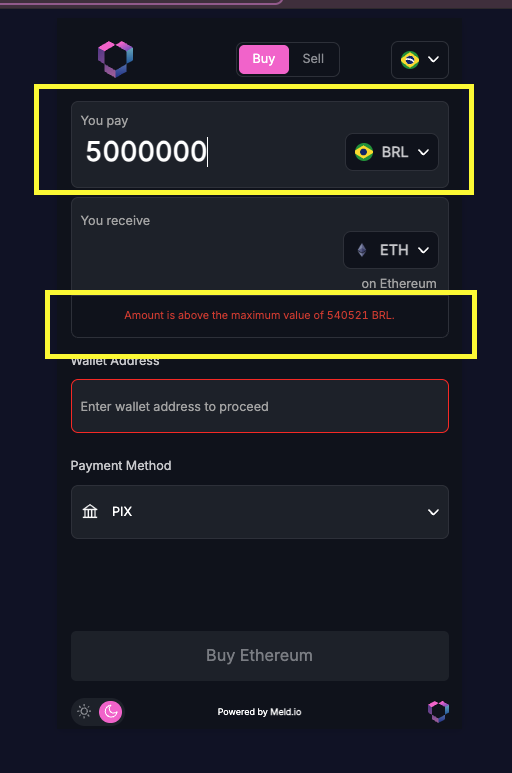 Screenshot: Meld Widget showing amount input with purchase limits validation
Screenshot: Meld Widget showing amount input with purchase limits validation
Caching Note:
Performance Tip: The data in steps 1-4 rarely changes. Cache responses for 1 week to reduce latency.
Step 5: Get a Real-Time Quote
Fetch live pricing from multiple providers and display options to the user.
API Call:
// Sample Code: Get real-time quotes from multiple providers
POST /payments/crypto/quoteRequest Body:
{
"sourceAmount": "200",
"sourceCurrencyCode": "USD",
"destinationCurrencyCode": "ETH",
"countryCode": "US",
"walletAddress": "0xfCFAa8059080D01b27ccA2B1fA086df0853397E6"
}Response Example:
{
"quotes": [
{
"transactionType": "CRYPTO_PURCHASE",
"sourceAmount": 200.00,
"sourceAmountWithoutFees": 195.83,
"fiatAmountWithoutFees": 195.83,
"destinationAmountWithoutFees": null,
"sourceCurrencyCode": "USD",
"countryCode": "US",
"totalFee": 4.17,
"networkFee": 0.17,
"transactionFee": 2,
"destinationAmount": 0.04308219,
"destinationCurrencyCode": "ETH",
"exchangeRate": 4642.290,
"paymentMethodType": "CREDIT_DEBIT_CARD",
"customerScore": 20.00,
"serviceProvider": "UNLIMIT",
"institutionName": null,
"lowKyc": true,
"partnerFee": 2
},
{
"transactionType": "CRYPTO_PURCHASE",
"sourceAmount": 200,
"sourceAmountWithoutFees": 196.93,
"fiatAmountWithoutFees": 196.93,
"destinationAmountWithoutFees": null,
"sourceCurrencyCode": "USD",
"countryCode": "US",
"totalFee": 3.07,
"networkFee": 0.11,
"transactionFee": 1,
"destinationAmount": 0.042577,
"destinationCurrencyCode": "ETH",
"exchangeRate": 4697.4,
"paymentMethodType": "CREDIT_DEBIT_CARD",
"customerScore": 19.76,
"serviceProvider": "ROBINHOOD",
"institutionName": null,
"lowKyc": null,
"partnerFee": 1.96
}
],
"message": null,
"error": null,
"timestamp": null
}Response Fields Explained:
customerScore: Meld's recommendation score (higher = better conversion likelihood)lowKyc: Whether provider requires minimal identity verification
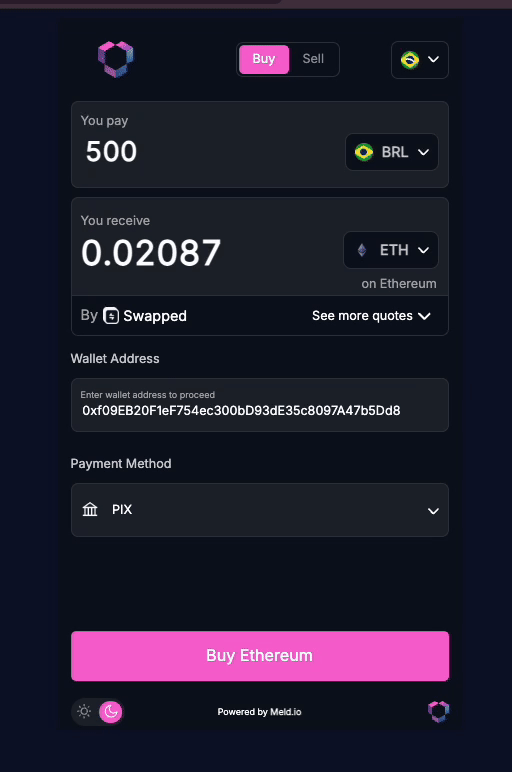 Screenshot: Meld Widget showing multiple provider quotes with ranking
Screenshot: Meld Widget showing multiple provider quotes with ranking
🏆 MELD RECOMMENDED QUOTE RANKING
Use Meld'scustomerScore for optimal conversion rates!
Meld provides a customerScore in each quote that represents the likelihood of transaction success based on:
- Historical conversion rates for similar transactions
- Provider reliability and success rates
- User location and payment method compatibility
- Real-time provider performance data
Recommended Quote Sorting:
// Sample Code: Use Meld's recommended ranking for best results
function rankQuotesByMeldScore(quotes) {
return quotes.sort((a, b) => {
// Primary: Sort by customerScore (higher = better)
if (a.customerScore !== b.customerScore) {
return b.customerScore - a.customerScore;
}
// Secondary: Sort by destinationAmount (more crypto = better)
return b.destinationAmount - a.destinationAmount;
});
}
Best Practice: Always display the highestcustomerScorequote first to maximize transaction success rates and user satisfaction.📊 Learn More: See Conversion Routing for advanced ranking strategies.
Step 6: Launch Provider Payment UI
When user selects a quote, create the provider session and get a provider URL to launch their payment UI in a webview, new tab, or redirect.
API Call:
// Sample Code: Create widget session to get provider URL
POST /crypto/session/widgetRequest Body:
{
"sessionData": {
"walletAddress": "bc1qxy2kgdygjrsqtzq2n0yrf2493p83kkfjhx0wlh",
"countryCode": "US",
"sourceCurrencyCode": "USD",
"sourceAmount": "100",
"destinationCurrencyCode": "BTC",
"serviceProvider": "TRANSAK",
"redirectUrl": "https://yourapp.com/transaction-complete"
},
"sessionType": "BUY",
"externalCustomerId": "user_123",
"externalSessionId": "session_456"
}Response Example:
{
"id": "WePLapZetkn1hfeKFScf3T",
"externalSessionId": "session_456",
"externalCustomerId": "user_123",
"customerId": "WXEX4DsAX7cp6Ch78oq2w3",
"widgetUrl": "https://meldcrypto.com?token=eyJhbGciOiJIUzI1NiIsInR5cCI6IkpXVCJ9...",
"token": "eyJhbGciOiJIUzI1NiIsInR5cCI6IkpXVCJ9..."
}Provider UI Launch Implementation:
Desktop Implementation:
// Sample Code: Launch provider UI in popup window
function launchProviderUI(sessionResponse, options = {}) {
const popup = window.open(
sessionResponse.widgetUrl,
'meld-widget',
'width=450,height=700,scrollbars=yes,resizable=yes'
);
// Note: Meld will redirect the user back when the transaction is complete
// The popup will need to be closed based on your application's flow
}Mobile Implementation:
// Sample Code: Launch provider UI on mobile
function launchMobileProviderUI(sessionResponse) {
// For webviews
if (isMobileApp()) {
window.ReactNativeWebView?.postMessage(
JSON.stringify({
type: 'OPEN_WEBVIEW',
url: sessionResponse.widgetUrl
})
);
} else {
// Mobile browser - full redirect
window.location.href = sessionResponse.widgetUrl;
}
}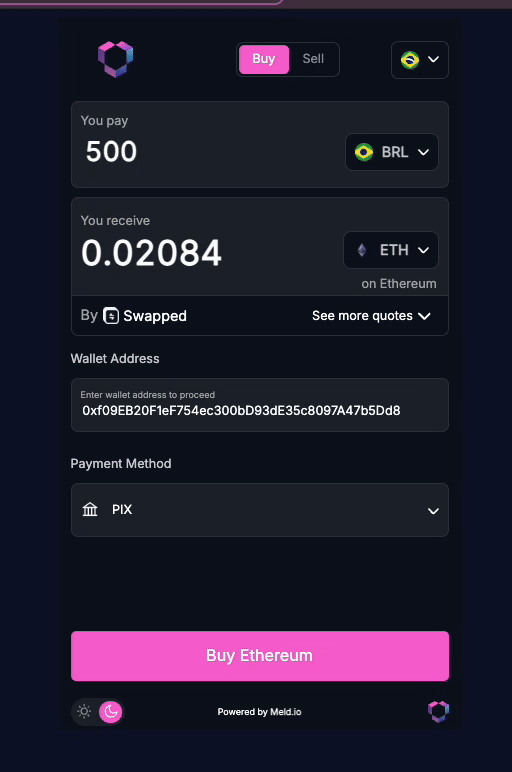 Screenshot: Meld Widget launching onramp service provider UI
Screenshot: Meld Widget launching onramp service provider UI
Important Notes:
Redirect Domain Whitelisting: Some providers require redirect domain whitelisting. Contact Meld support if provider UIs don't redirect back properly.📱 Mobile Considerations: Webviews are recommended for mobile apps, but external browser works too.
Transaction Completion: Meld does not send completion events or use redirect parameters. When a transaction is complete, Meld simply redirects the user back to your specifiedredirectUrl. You should track transaction status through webhooks, not through redirect handling.
Step 7: Track Transaction
Monitor transaction progress and update your UI as the user completes the flow.
Webhook Setup Required: Sign up for webhooks in the Meld Dashboard. You will receive a webhook each time a transaction is created or updated.
Webhook Integration:
// Sample Code: Webhook endpoint receives transaction updates
app.post('/webhook/meld', (req, res) => {
const { transactionId, status, externalCustomerId } = req.body;
// Use webhook as trigger to fetch full transaction details
const transactionDetails = await fetchTransactionDetails(transactionId);
// Update user's transaction in your database
updateTransaction(transactionId, transactionDetails);
// Notify user via websockets, push notifications, etc.
notifyUser(externalCustomerId, {
transactionId,
status,
message: getStatusMessage(status)
});
res.status(200).send('OK');
});
// Sample Code: Fetch transaction details when webhook arrives
async function fetchTransactionDetails(transactionId) {
const response = await fetch(
`/payments/transactions/${transactionId}`,
{
headers: {
'Authorization': `BASIC ${apiKey}`,
'Meld-Version': '2025-03-04'
}
}
);
return await response.json();
}Transaction Status Display:
// Sample Code: Display user-friendly status messages
function getStatusMessage(status) {
const statusMessages = {
'PENDING': 'Processing your transaction...',
'SETTLING': 'Finalizing crypto transfer...',
'SETTLED': 'Complete! Crypto sent to your wallet.',
'FAILED': 'Transaction failed. Please try again.',
'CANCELLED': 'Transaction was cancelled.'
};
return statusMessages[status] || 'Transaction status updated.';
}![]() Screenshot: Meld Widget showing transaction status tracking
Screenshot: Meld Widget showing transaction status tracking
Status Reference: See Transaction Statuses for complete status definitions.
API Response Caching Guide
Optimize performance by caching static data and keeping real-time calls fresh.
Cache Weekly (Static Data):
const CACHE_WEEKLY = 7 * 24 * 60 * 60 * 1000; // 1 week in milliseconds
// Cache these API responses:
- Countries list
- Fiat currencies by country
- Payment methods by currency
- Crypto currencies by country
- Purchase limits by currencyReal-Time Calls (Never Cache):
// Always fetch fresh:
- Crypto quotes
- Widget session creation
- Transaction details
- Transaction statusImplementation Example:
class MeldAPICache {
constructor() {
this.cache = new Map();
}
async getCountries() {
const cacheKey = 'countries';
const cached = this.cache.get(cacheKey);
if (cached && Date.now() - cached.timestamp < CACHE_WEEKLY) {
return cached.data;
}
const data = await this.fetchCountries();
this.cache.set(cacheKey, {
data,
timestamp: Date.now()
});
return data;
}
}Best Practices & Tips
Performance Optimization:
- Cache static data for 1 week
- Debounce quote requests when user types amounts
- Preload country/currency data on app startup
- Use CDN for crypto icons and assets
User Experience:
- Show loading states during API calls
- Display fees clearly before transaction
- Provide transaction estimates (settlement time)
- Handle errors gracefully with retry options
Error Handling:
async function handleAPIError(error, endpoint) {
const errorMap = {
401: 'Invalid API key or authentication failed',
403: 'Access forbidden - check account permissions',
429: 'Rate limit exceeded - please wait and retry',
500: 'Server error - please try again later'
};
const message = errorMap[error.status] || 'Unknown error occurred';
// Log for debugging
console.error(`API Error (${endpoint}):`, error);
// Show user-friendly message
showErrorToUser(message);
}Security Considerations:
- Never expose API keys in frontend code
- Validate all user inputs before API calls
- Use HTTPS only for API communications
- Implement rate limiting to prevent abuse
Next Steps
Testing Your Implementation:
- Testing Guide - Comprehensive testing strategies
- Sandbox Environment - Test with fake data
Advanced Features:
- Webhook Events - Real-time updates
- Dashboard Data - Track performance
- Conversion Optimization - Improve success rates
Production Deployment:
- Service Provider Setup - Configure providers
- Integration Options - Domain setup and integration guide
Support & Resources
- Complete API Reference - All endpoints documented
- Postman Collection - Test APIs directly
- FAQ - Common questions answered
This guide provides everything needed to build a production-ready crypto interface. Most teams complete their custom UI integration within 1-2 weeks using this approach.
Updated 2 months ago